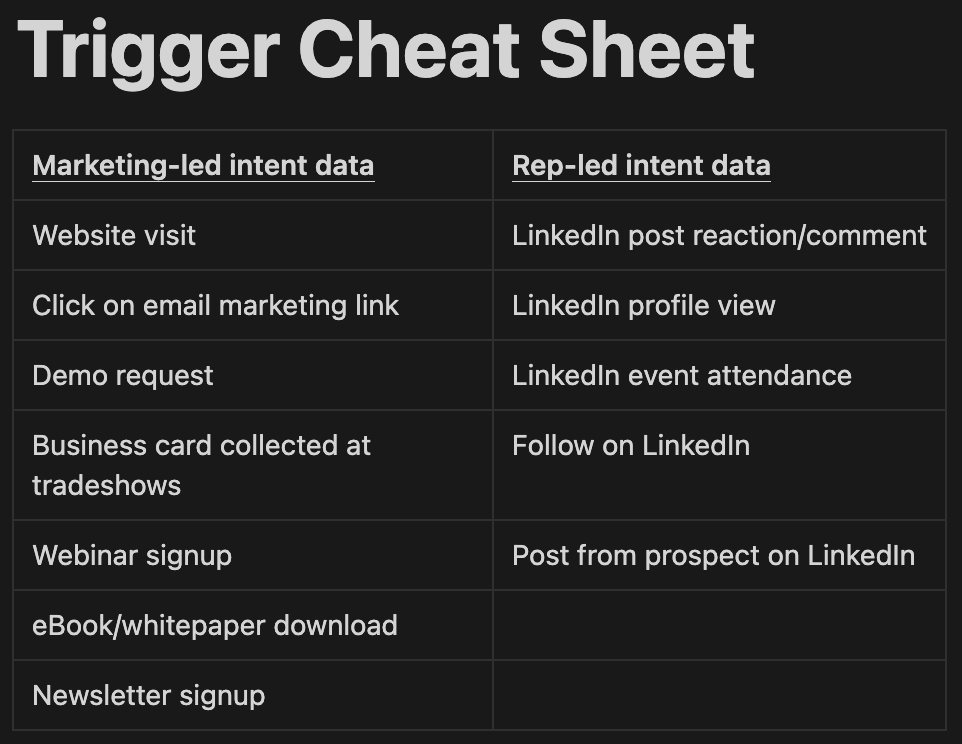The Prospecting Engine is finally live! You can grab the Do-It-Together package for 50% off before the community launches on the 21st of February.
In today’s issue, I’ll share exactly how I use triggers to get a 46.45% reply rate. Without understanding intent-data and how to use triggers, you won’t book outbound meetings in 2024. However, if you use triggers to create relevant outbound messages, prospects will pay attention to what you have to say, they’ll reply more, and you’ll book more meetings as a result.
Here’s how:
Before reaching out to your prospects, you need to understand what is intent-data, and how you can use it to make your prospecting more relevant. In short, intent-data is data about a potential buyer’s online behavior that indicates what they could likely do next or buy.
For example, your marketing team will use website visits, clicks on email marketing links, or a business card collected at a tradeshow as intent-data. They then nurture the leads until they request a demo, or pass them directly to you (the salesperson) to try to book a meeting.
This kind of intent data is interesting, but you have no control over it. That’s why I suggest using a second type of intent-data – the one you find on LinkedIn. Post reactions/comments, profile visits, LinkedIn event attendance are all great intent-data you can use.
Now that you know better about intent-data, you can start listing potential triggers you can use to start conversations with your prospects. This is what I call trigger-based prospecting – you focus on finding interesting creators and influencers who attract your ICP, and use the post reactions/comments as triggers.
For example, I love using posts from other creators to find potential prospects to reach out to. That’s why I recommend listing the types of triggers you want to track, so you are sure you know what you’re looking for. Here’s a cheat sheet to help you list your triggers:

You now have a good understanding of intent-data, and how it translates into triggers. You can use this “digital footprint” as an excuse to start a conversation with you prospect.
For example, when prospects visit my profile, I use a variation of this message:
“FirstName, saw you recently landed on my LinkedIn profile. There are a few resources I can send your way if your team is struggling to get replies. Worth a peek?”
When a prospect likes a creator’s post, I use a message like this one:
“Thomas, saw you also liked Kyle’s post on next steps from bad salespeople vs good salespeople. I may have a resource to help your reps build a habit of setting follow-up calls in the same week. Worth a peek?”
As you can see, I always use the trigger as an excuse to start a conversation, and I tease a potential resource to help solve a problem that could be related to this trigger.
If you need more inspiration, you can find over 20 cold outreach templates in my swipe file.
These are 3 easy steps I follow to use triggers and get a 46.45% reply rate.
Hope this helps.
Cheers,
Thibaut
P.S. When you’re ready, here are 3 ways I can help you:
→ (NEW) Grab the Do-It-Together package of the Prospecting Engine for 50% off (valid until 21st of January)
→ (NEW) Need to train your team or invite me as a speaker? Book a call here
Get my free, 4 min weekly newsletter. Used by 5.900+ salespeople to book more meetings and work when, where, and how they want.
Get my free, 4 min weekly newsletter. Used by 5.900+ salespeople to book more meetings and work when, where, and how they want.
I will never spam you, or sell your info.
Get each episode in your mailbox when they release. Grab special discounts and offers.